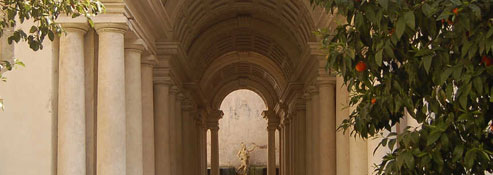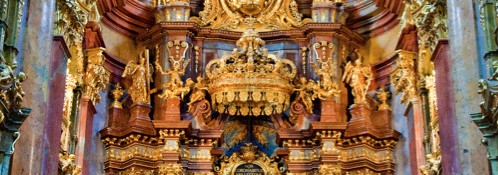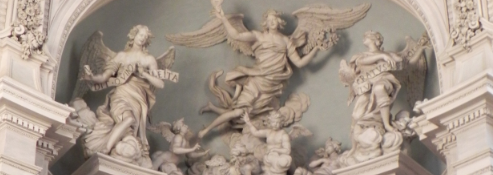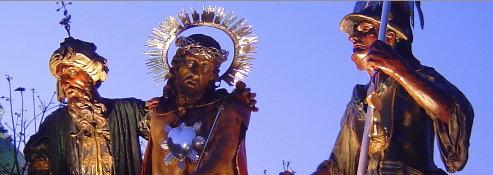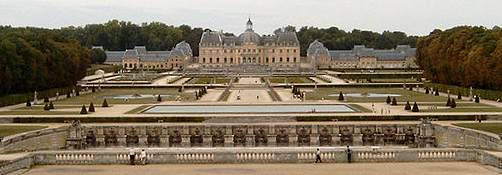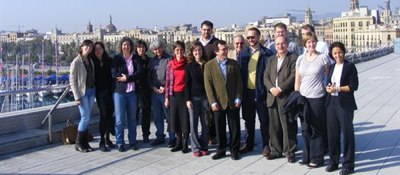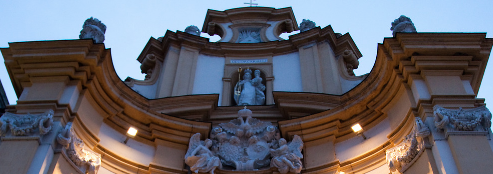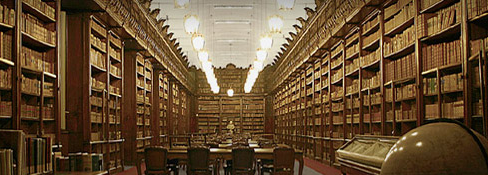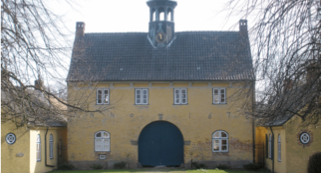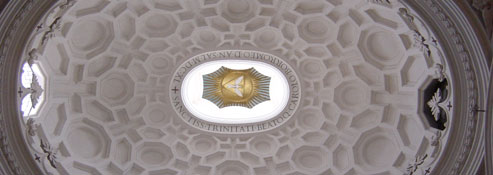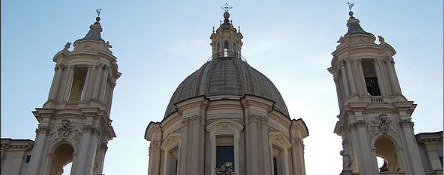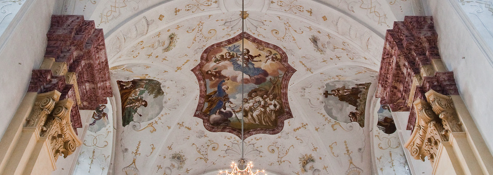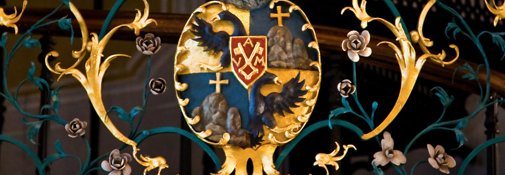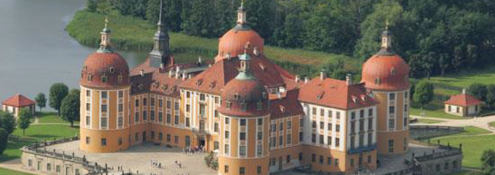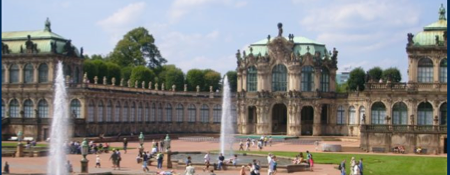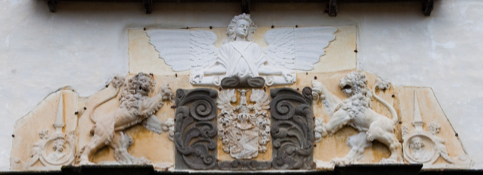Some General Observations
The present discussion offers some observations concerning the treatment of several Baroque qualities in Hebrew Baroque poetry. It will focus on the work of three poets that brought that poetry to its peak in Italy, namely, Moses Zacuto (c. 1610 - 1697), Jacob Frances (1615-1667) and his brother Immanuel (1617- c.1710). [1] The Baroque nature of their poetry did not go unnoticed by scholars. [2]
Here, however, I would like to survey that issue in the light of the recently published corpus of Zacuto's poems. The two hundred poems that make up that corpus allow for the first time a comprehensive analysis of the poetical product of that most prolific poet in its entirety, and consequently a fresh review of his oeuvre, as well as that of the other poets mentioned, as I hope to demonstrate here.
In seventeenth-century Italy conditions for introducing Baroque manners into Hebrew poetry were optimal. [3] Italian and Sephardic Jews were naturally fluent in Italian, Spanish, and Portuguese and the learned among them, being well-versed in those literatures became easily familiar with their Baroque styles. These styles, however, were not only readily available, and as "state of the art" poetry highly attractive, but also easily adoptable, having much in common with Hebrew literary traditions.
Immanuel Frances summed up his ars poetica "Meteq Sefatayim" or "Sweetness of lips" arguing that a poem, even if perfect in prosody, that lacks "sharpness" is nothing more then a body without a soul. [4] He thus coined the characteristic quality of Hebrew Baroque poetry: "sharpness", or ḥ arifut in Hebrew. In this term he wrapped together agudeza, acutezza, cultismo, conceptismo, and meraviglia with no distinction, attesting to its triple roots, the Italian, the Spanish, and the Hebrew. The term ḥ arifut or sharpness is a commonplace in the field of Talmud, where ḥ arif denotes a sophisticated scholar; and an extremely sophisticated method of study is called pilpul - meaning peppering, or savoring with hot spices. The ways in which the Holy Scriptures are being customarily read include Baroque-like technicalities, such as the drawing together of sayings located far apart in the Scriptures on account of a word or an expression they have in common, with the intention of illuminating one with the other; the use of hypothetical extraordinary situations to prove a point; extraction of hidden messages from the Scriptures by applying unusual meanings to words, and more such clever methods that might easily fit into Frances' scope of poetical "sharpness". [5] Biblical, as well as traditional poetical sources could supply expressions fit to be transformed into sharpness. But the models for Baroque sharpness were of course contemporaneous Italian and Spanish.
Immanuel Frances, regardless of his zealous approach to Hebrew displays not only a familiarity with, but also a high regard for the surrounding poetries. Reprimanding a Jewish poet for preferring Italian over Hebrew he says: "What business have you with the poem of Marin (Marino) and Maron (Virgil)? The song of Merari sing, and of Gershon (Psalmists). [6] In the same vein he conditions successful composition of Hebrew sonnets on "purity of language" which means avoiding any foreign linguistic influence. But then he adds, that "One who is not well-versed in the poems of the Christians will not succeed with them." [7] In a second version of the text "Italian" replaces "Christians." But our three poets were evidently no less close to the Iberian sources as to the Italian. A manuscript containing Jacob's poems in his own hand writing that had fortunately survived [8] includes numerous self-directed notes as well as three of his poems in Portuguese. [9] Moses Zacuto left several letters to family and friends in that language. Naturally, the great poets of the "siglo de oro" also had their appeal for the Hebrew authors.
Let us now examine the treatment of several Baroque traits by those poets, with some attention to these three nurturing sources.
The Bizarre
The brothers Frances showed poetic "sharpness" by describing bizarre poetic situations. In a sonnet with an octave composed by Jacob and a sestet added posthumously by Immanuel, the speaking persona is in love with a woman's portrait. [10] In a state of disillusionment (or "desengaño" [11]) the lover puts his folly in perspective:
Tell me, wooden tablet, explain how it is
That I upon the tablet of my heart have you engraved?
Since the day we met only you I craved,
No rest have I known since then, alas, no peace.
Why and upon what my eye a stream of tears
Became, that chokes me like a wave?
How my happy heart to naught I gave?
My soul I pour onto one who lifeless is.
Chained by colored chains unto a piece of wood
I am, since when I saw upon it copied
An image of the beautiful gazelle,
And then declared: Oh, would
That I be matter upon which she is embodied,
Though only color - in her shade to dwell. [12]
But rational disillusionment hardly affects the poet-speaker's emotional infatuation caused by art. Hence the solution the frustrated lover suggests at the end of the poem: his turning into matter, a concept which in medieval philosophical symbolism is opposed to substance, which means losing one's soul; dying. At the same time it is also highly erotic. Stretching ad absurdum the impact of love, the poet raises awareness of its fatal power. Reminiscent of the myth of Pygmalion, this sonnet is also its opposite: it is not the soulless object's metamorphosis into a living creature that ends it but the lover's metamorphosis into a dead object.
A similarly bizarre situation unfolds in a sonnet by Immanuel Frances. The lover is attracted to two women at the same time and prays to Love to free him from his bondage by either granting him an additional heart or else having his heart slashed in two. [13] The heart is treated here as both a synecdoche for love and a biological organ. The "slashed heart" can be perceived in medieval poets such as Samuel ha-Nagid and Solomon ibn Gabirol [14], but there it helps convey not so much bizarreness as longing or sorrow.
In his Portuguese Gramatica Hebraica (Hamburg 1635), Moses Abudiente commended the popular baroque genre of the echo-poem [15] as an efficient tool to convey "singulares curiozidades." [16] Thus he disclosed the Baroque quest for the uncommon and affirmed its poetic value in Hebrew theory, though in the Portuguese tongue.
Obsession with death
The above sonnets present the bizarre in its extremity: Death, the epitome of the unfathomable and the obscure. J.M. Cohen saw the Baroque as an "age in which western man was haunted by the image of death." [17] This hypothesis can find no better verification than in the poetry of Jacob Frances and Moses Zacuto, the most Spanish oriented of the three poets. It is not the old, detached "ubi sunt" that fills many of Jacob's poems with the image of death, but fascination with its very essence, and the feeling of its immediate proximity. Hence his preoccupation with his own death, constant even "under the wedding canopy," and his attraction to a "dance macabre" painting. He is perhaps the only Jewish poet that encourages a jealous husband to "put a knife to the throat" of an unfaithful wife or wishes to do so to himself, or longs to become a corpse in order to score a kiss from a young widow In several of his sonnets a physician or adversary proves to be Death in disguise. In one sonnet he indulges in a poetic hallucination of his own identification with its image. [18]
There is no doubt about Zacuto's fascination with death. Of his two plays, one is an Inferno, the other has at its center an argument concerning human afterlife. Out of 200 of his poems, more than eighty are funerary poems and dirges. And death is a common factor in his twenty moral poems, in which his vision of death might verge on nihilism: "Vehakol Ayin" "and all is nothing,", as concludes one of them [19] - perhaps an intensified echo of Góngora's famous "Mientras por competir con tu cabello" with the sharp "en nada" at its conclusion. But there annihilation, impressive as it may be, is still restricted to human beauty alone. [20]. Could Zacuto's nihilism touch Divinity itself? Perhaps. Here we might encounter Zacuto as an ardent Lurianic kabbalist, who believes in the human power to affect the cosmos and the Godly flow within the sefirot for better or worse [21] and whose religious convictions agree with Baroque moods.
Motion and fleeting time
"An entire series of concepts playing a role in different aspects of baroque culture were linked to movement as the fundamental principle of the world and human being: the notion of change, modification… transformation, time… " [22] The soul's mystical trip to heaven is the subject of many of Zacuto's poems. Even in the necessarily short texts of tombstone poems that process of metamorphosis is evident in terms of dynamic movement, when the elemental factors of the situation change their identity. By use of homonym and metaphor a diseased lady may become a moon among the stars; a graveyard is transformed into a pleasant estate and a blessed valley, a date is turned into "a heavy day" and a "year of goodness". All that shifting occurs within the scope of a five-line poem. The soul, in many of those poems is in figurative motion: it goes up, travels, flies; set free, it follows the sun, runs, hurries, turns away, goes away, returns, escapes and is led. [23] More than once quickness of motion is explicit, if not dazzling with frequent ups and downs, as in a tombstone poem for R. Nathan Shapira that may be paraphrased in a somewhat truncated fashion: Up went Rabbi Nathan, who dives unto the deepness of knowledge; up from the depth of evil to the depth of goodness, five hundred miles to the tree of life; up to the depth of Creation which is Wisdom, up to the end of Mercy, to turn hell into grace at the end of time. [24] Even this much simplified paraphrase retains something of the forceful dynamic mood of the original.
"Rabbi Immanuel ben Solomon who was the first to introduce sonnets into the holy tongue - were mostly not to my taste, since he wrote them with a heavy hand" says Immanuel Frances in his ars poetica [25] . In the seventeenth century when awareness of the passing of every single moment was made unavoidable by the exact mechanical measuring of time, the fourteenth century bipartite sonnet, carefully divided into symmetrical units, that "took its time" to develop and allowed the reader or listener time for reflection [26] seemed intolerably slow. The Frances brothers preferred now a new type of sonnet, in which the ancient sense of fleeting time (Ps 39: 6 - 7; 103: 15 - 16; 144: 4; Job 4: 1 - 2; 14: 1 - 2, 10) was infused with the Baroque sense of emergency. Employing a technique invented by Giovanni Della Casa several decades earlier they would phrase a whole sonnet as a single sentence, to be read in one breath. [27]
Jacob Frances infused with motion the old-time genre of lament, in a dirge for a Venetian rabbi by employing a continuous metaphor that identified the dirge with the concept of a ship [28]. Splitting into subordinate metaphors (the author is the ship's builder, "time's occurrences" and the author's tears - its building materials, the diseased - its mast, etc.) it stretches over fifteen lines of elevated prose. [29] Then, this "ship of lament" (in Hebrew a heterograph: (oniyat aniyah), that symbolizes the transience of life suddenly changes into an even more dynamic battleship, to wage a paradoxical war against Time, the epitome of transience. Already Moses Ibn Ezra compared fleeting time to a ship that carries the unaware passenger towards death. [30] But he did it through simile that is naturally static, while metaphor in its very definition as a shift of meaning from one semantic field to another implies movement. Zacuto, too, used the ship simile, but while Ibn Ezra emphasizes its moving "slowly", Zacuto emphasizes its speed: "quickly." [31]
In Frances' dirge metaphoric movement is indeed three-fold, as it is generated from a metaphor, whose "vehicle" is a moving object, and that vehicle undergoes change. Ibn Ezra, to continue the comparison, conveys a complete surrender to Time that symbolized both chronology and fate, whereas Frances fights back, helped, to enhance the paradox, by the enemy's typical weapons - "occurrences" - recruited to build his metaphorical battle craft. But with defeat inevitable, Baroque stormy movement dies down and gives way to the old-time unsophisticated, plain formula, to conclude the dirge: "God will say 'enough' to our troubles" - a good example of the poet's way of integrating the Baroque mood with traditional convention.
Appearances and reality
If Jacob Frances, relying on falling in love with a portrait, presented giving in to an appearance as an inadvertent, fatal affair (in a second sonnet on the same theme responsibility is put on "blind cupid" [32]), Moses Zacuto regarded it as sin, committed by free choice [33]. In his Inferno (a dramatic piece forged in the Spanish Quintilla verse-form) the protagonist-sinner, is demanded to face facts: that he is dead (and not as he imagines - alive and in his sick bed); that he is in the underworld, beholding the flames of hell (not in some remote quarter where kitchen stoves are located outdoors); that he must be punished (not as he expects - to be exempted by ransom). To help him see all that a destroying angel appears, and answers his frightened exclamations with hinting echoes. Here are several lines from that echoing dialogue in translation:
| - Out of the haters' den you emerge | |
| Against me! Who has called for you? | You |
| - Who lured me here with his lie? | I |
| - When have I become your pastime? | Past time |
| - Take ransom, my stones precious | Ashes |
| - All dear plants I have planted | |
| In valley and upon hill | Nil |
But the sinner refuses to face facts and shuns the hinting echoes:
"I had enough of your bat-qol! Speak up clearly! Tell me what these blazing fires are!"
Since bat-qol means in Hebrew both echo and the voice of God, this declaration means a rejection of divine truth.
The Baroque-confused labyrinth-like existence was forced on the sinner as punishment, but he was not denied free choice. Only when he fails to take advantage of the chance to escape confusion by repentance is it further augmented by the destroying angel's answering monologue. Fraught with unfathomable archaic language, no less ambiguous than any poem by Góngora, it is more stunning than clarifying as it reveals the sinner's crimes. But his speech becomes easy to follow when he goes on to the departments of Hell that function as purgatory. Here sinners are forced to face the facts they refused to face of their own free will. Purged from the sin of evading the truth they are allowed a glimpse at Paradise, as they admit they have sinned. The play ends in this metaphysical grasp of truth [34].
Reminiscent of Jean de la Ceppède's Théorèmes, Moses Zacuto's Hagiographical drama Yesod Olam, or Foundation of the World, (the traditional designation for Abraham the Patriarch), represents the richness of the mask that covers reality by a great variety of verse-form and meter, that constitute the text throughout. No less marvelous is the backbone for that prosodic construction that is formed by sonnet sequences of complex symmetry, now attached now detached by rhyme, meter, and syntax. This complex symmetry is of such a degree of precision that it not only leaves no doubt about the existence of a whole prosodic plan for the play whose end is now missing, but makes possible an hypothetical reconstruction of that plan as a whole . [35] Against that aesthetic appearance harsh reality is revealed when the Patriarch is sentenced to death. But earthly reality succumbs to Divine power when the Patriarch is saved by its miraculous intervention. Here Zacuto demonstrates his metaphysical approach: his belief in the existence of Divine truth beyond appearances and within reality.
F. J. Warnake might have included Zacuto's plays in his observations concerning the religious poetry of several Baroque poets, for their "concern with the divine … that … expresses itself … through the acting out of a tens dramatic situation, an agon in which the contestants may be God and the soul, the soul and some personified abstraction…" [36].
The Baroque worldview in terms of appearances and reality, the concept of sharpness and the metaphysical approach, are all combined and conveyed in the most straightforward way in the Hebrew Emblem riddle, invented by Moses Zacuto, who modeled himself on the Spaniard Alonso de Ledesma, as proposed by Dan Pagis, the investigator of the genre [37]. Famous throughout the siglo de oro, Ledesma is still considered in research to be the initiator, or at least one of the initiators, of Spanish Conceptismo. Zacuto, in parallel, drew to the Hebrew version hundreds of followers, fascinated by its typical sharpness. One of these was Immanuel Frances, who composed two such riddles, and commented on the genre in his ars poetica, stressing its sharpness and pointing to its double entity: "[it is] a sharp saying, that sharpens the mind of those who attempt to solve it, to render her misleading phrasing straight, and to unmask her from the hints that cover her face, for she is disguised." [38] Pagis paid much attention to the element of sharpness evident in Frances' definition, not so much to the issue of appearance versus reality which is no less evident in it [39]. Pagis completed his study while Zacuto's own riddles - seventeen in number - were still in manuscript, except for three that he solved and published. [40] I solved the rest and published the whole collection more then fifteen years later. [41] With the solutions juxtaposed with the riddling texts the aspect of appearances versus reality springs to the eye. Zacuto's emblem riddles, except for one, were intended for weddings. They are crammed with linguistic wit, and may indeed be defined as continuous conceits (their length may exceed fifty lines). As such they shed the mood of Baroque confusion, [42] hardly desirable at a wedding. That mood is uplifted by the solutions that show a way out of it. Zacuto's solutions are often symbols for sacred entities: water or wheat that stand for the Law, or Hebrew letters that imply holy sefirot. Jewish mysticism that believes in the magical power of the Hebrew word mingles here with Góngoroean sophistication. [43]
Impact of the new science
The impact of the newly revealed cosmos may be observed in the poems of our three Baroque poets. Immanuel Frances involved a "chanochialo" as a means of proof in a dramatic "Dispute." [44] A lot of attention was paid to celestial objects, frequently with a modern flavor, and mostly to the sun, queen of the heliocentric system. [45] The same poet explains that the moon gets its light from the sun, and then belittles himself before a respected rabbi, in line 14 of a sonnet, making a sharp point: You are a sun, I only a moon. [46] He devotes thirteen lines of a sonnet to the splendor of the sun. Indeed, a turned, sharp simile is introduced into the last line: to give that celestial luminary the praise it deserves the poet compares it to his bride. But we hear nothing of the bride, and the sun remains the main topic. This poetic adoration of the sun is a novelty in Hebrew poetry that tended to give priority to the moon as sacred symbol ever since the lunisolar Jewish calendar was established. Moses Zacuto stays loyal to the traditional preference in his obviously Kabbalistic poems [47] while extensively employing the novel attitude in many of the rest. [48] The theme of one of his riddles is the sun. [49] In an introduction to a dirge on his dead teacher he compares him to the sun, repeating the word sun (shemesh) serves as an anaphoric link for not less then fourteen sentences. [50]
Interestingly enough, none of the three poets discloses any sign of the "disturbing affect" that the new science had on Baroque contemporary poets. [51] Rather, they seem to regard the new cosmos as a reflection of the infinite greatness of the Lord. Zacuto mirrors it in a grand style: Like a painter who applies bold brush- strokes of paint to a canvas he lets his muse fill a greatly expanded text by drawing one picture after another and leap with great speed from one pole of the earth to the next, from the lowest heaven to the highest. When a group of scholars concluded their study of a Talmudic tractate he commemorated the event with a long poem, where the starry system, the sun, the moon, the Zodiac, angles, the beasts of the holy chariot, the seven skies, the elements of nature, biblical rivers, living creatures on earth, in the air and in the seas - all take part in the celebration [52].
* * *
The three poets into whose treatment of Baroque manners I have tried to provide some insight may all be regarded as poets of wit wonderfully conveyed in Hebrew, and as innovators that combined Baroque manners with Hebrew literary traditional convention. But Zacuto stands alone, as I tried to demonstrate, as a poet of the Kabbalah who used Baroque manners to express his own worldview, by means of the magical power of the Hebrew word.
Notes
1. For short biographies of the three poets including bibliographical references cfr. D. Bregman (ed.) Tzeror Zehuvim, sonetim Ἰvryim mi-tekufat ha-Renaseans ve-ha-Baroq (A Bundle of Gold, Hebrew sonnets from the Renaissance and the Baroque) Jerusalem 1995, p. 242, pp. 305-306, p. 382. For a detailed biography of Zacuto see D.Bregman (ed.) Essa et Levavi, Poems by Moses Zacuto, Jerusalem 2009, pp.5- 24. Editions of the Frances brothers' poetry are mentioned in the following notes.
2. I will mention some of it in the following notes.
3. I will not deal here with the problem of social criticism concerning literary borrowing from foreign sources. For that cfr. D. Bregman, The Golden Way, The Hebrew sonnet during the Renaissance and the Baroque, trans. Ann Brener, Tempe, Arizona, 2006, pp.77, 100 - 103; in more detail Cfr. D. Bregman, Parish ha-hitkablut shel ha-sonet ha- 'ivri", in Tarbitẕ 56 (1987) pp.109 - 123. Cfr. also D. Bregman, "Their rose in our garden: Romance elements in Hebrew Italian poetry" in Renewing the Past, Reconfiguring Jewish Culture from al-Andalus to the Haskalah, Philadelphia 2003, pp. 50 - 59. Jacob Frances was the most vulnerable of the three to social criticism.
4. H. Brody (ed.) Meteq Sefatayim me'et ha- meshorere Rabbi Immanuel Frances , Krakow 1892, p. 53
5. Cfr. F.J. Warnake, Versions of Baroque, New Haven and London 1972, p. 18 - 19.
6. S. Bernstein (ed.) Diwan le Rabbi Immanuel ben David Frances, Tel Aviv, 1932, p. 49 (see also p. 241); Immanuel Frances, Meteq Sefatayim, cit, in Brody's introduction, P. 11. See also D. Bregman Tzeror Zehuvim, cit., p. 253.
7. Ḥ. Brody (ed.) Meteq Sefatayim, cit., p. 48; Oxford, Bodleian Library 2000, Poc.7, fol. 11; London, British Library, Add. 27095 (Cat. Margoliouth 1077), fol. 12.
8. Oxford, Bodleian Library, (Cat. Neubauer 1991).
9. His Portuguese notes cfr. P. Naveh (ed.), Kol Shirey Yaacov Frances, Jerusalem 1969, within the editor's notes. Two Portuguese poems cfr.ibid, pp. 564 - 574. As the editor observed, their poetic ripeness suggests the existence of a broad unknown poetic product in that language. .
10. "Luach emor", in D.Bregaman (ed.) Tzeror zehuvim, cit., p. 308. The sonnet was first published in P. Naveh (ed.), Kol Shirei Yaakov Frances, cit., with a misleading mistake in line 14. Concerning the main motif of that sonnet in Giambatista Marino and several Marrinisti - crf. A. Rathouse, "Ahava lidioken, shenei sonetim Ἰ vryim min ha- mea ha-sheva esre al reka sifrut ha-baroq h-italkit" in Italia 2 (1981) pp. 30 - 47.
11. On engaño / desengaño and ser/ parecer (illusion / disillusion, be / seem to be) as a basic concepts in Spanish Baroque cfr. J. Robbins, "Arts of Perception, the Epistemological mentality of Spanish Baroque" New York 2007.
12. The translation is mine.
13. D. Bregman, Tzeror Zehuvim, cit. p. 389.
14. Ibn Gabirol, "I am the man", in P. Cole (ed.) The Dream of the Poem, Hebrew Poetry from Muslim and Christian Spain, 950 - 1492, USA 2007 pp. 86 - 89. (Cole translated the original "heart" as "mind": "a man whose mind has been split by his mind" (line 3). Cfr. also my "'El turbante blanco' " como motivo en la poesía secular de Salomon ibn Gabirol" in J. Targarona Borrás, Á. Sáenz-Badillos (eds. and trans.) pp. 151 - 172.
15. I am currently working on a monograph of the Hebrew version of the genre. For now see my "' Nefashot be-zivug nichnasot ke-gever be-alma' ('Souls enter into unity like a man with a maiden') A Manuscript reveals the name of an unknown author of an echo poem put to music by Salamone de Rossi", in h-aaretz Literary Supplement, September 22, 2010; " 'Hen ata tihie al biti even' ('For now a stone lies on my daughter'), gravestone poems by Moshe Zacuto", in Studies in Arabic and Hebrew Letters in Honor of R. P.Scheindlin, Piscataway, 2007, pp. 13-21 [Hebrew section].
16. Gramatica Hebraica, Por Moshe filho de Gideon Abudiente Em Hamburgo 3 de Elul, Anno da criasam 5393, P. 163 (erroneously printed: 173).
17. J. M. Cohen, The Baroque Lyric, London 1963 p. 30
18. D. Bregman (ed.), Tzeror Zehuvim, cit., p. 312, 362, 317:3, 309, 329 and more, and p. 327.
19. "Mi hu asher yimshol" (Who is it that will reign), an echo poem, in D. Bregman (ed.), Essa et Levavi, cit. p. 321.
20. Sonnet no. clxvi, in various publications.
21. Cfr. D. Bregman, "Moses Zacuto Poet of Kabbalah", in Renaissance Sources and Encounters, Leiden: Brill, 2011, pp.170 - 181.
22. J. A. Maravall, Culture of the Baroque, analysis of a historical structure, Trans. T. Cochran, in Theory and History of Literature Vol. 25, Manchester 1986, p 175. On the notions of fleeting time and measured time in Spanish and Italian Baroque cfr. ibid. p.185 onwards; J. M. Cohen, The Baroque Lyric, cit., pp. 15 - 29.
23. D. Bregman (ed.) Essa et Levavi, cit., p. "Achuza neima", p. 394;pp. 376, 377; 379, 382, 393; 383, 394; 384, 389, 397 - 398; 385; 390; 398; 400, 402.
24. "Alah rosh ḥodesh ziv" ibid, p. 164
25. H. Brody (ed.), Meteq Sefatayim, cit., p. 48
26. In the sonnets of Immanuel of Rome reflection is systematic. Crf. D. Bregman, The Golden Way, cit., p. 57 - 64.
27. Cfr. Ibid, pp. 163 - 165.
28. Cfr. F.J. Warnake, Versions of Baroque, cit., p. 71 - 74.
29. P. Naveh, Kol Shirei Yaakov Frances, cit. pp. 522- 523; J.M. Cohen, The Baroque Lyric, cit. pp.17-18 cites Jean du Bellay:"I am the mariner, my thoughts are the sea, sighs and tears are the winds and the storm … "
30. Moses Ibn Ezra, "Yizqor gever bimei ḥayav", in. Ḥ. Brody (ed.) Shirat Ha- Ḥol shel Moshe Ibn Ezra, Berlin 1934, Vol.1, p. 67.
31. D. Bregman (ed.) Essa et Levavi, cit., p. 320.
32. "Eich 'eese dod", in D. Bregman (ed.), Tzeror Zehuvim, cit., p. 310.
33. On appearances versus reality in Baroque poetry cfr. F. J. Warnake, Versions of Baroque, cit., pp. 21 - 51; J. Robbins, "Arts of Perception" cit.
34. On hell functioning as purgatory in Zacuto's Inferno cfr. D. Bregman "Amimut u-vehirut be- 'tofte aruch' le-Rabbi Moshe Zacut" in P'eamim, Studies in Oriental Jewry 96 (2003) pp. 35 - 52.
35. D. Bregman, The Golden Way, cit., pp. 256 - 260.
36.F.J Warnake, Versions of Baroque, cit., p. 93.
37. D. Pagis, Al Sod Hatum, le-toledot ha- ḥ ida ha-'Ivrit be-Italia uve-holand, (A Secret Sealed, Hebrew Baroque Emblem Riddles), Jerusalem 1986, pp. 28 - 33; pp.. 32, 113, 119; D. Pagis, "Yesodot baroqiyim ba-shirah ha-'Iivrit be-Italya al pi sug sifruti bilti yadua" (Baroque Elements in the Hebrew Poetry in Italy, based on an unknown literary genre), in E. Fleischer (ed.), Poetry Aptly Explained, studies and essays on Medieval Hebrew Poetry, Jerusalem 1993, pp. 256 - 270.
38. H. Brody, Meteq Sefatayim, cit., p. 54.
39. Pagis, Al Sod H atum, cit., p. 41.
40. Ibid, Appendix, pp 225 - 238.
41. D.Bregman (ed.), Essa et Levavi, cit. pp. 137 - 221.
42. Pagis, Al Sod H atum, cit., p.15.
43. Collin Thompson perceived that approach in Fray Luis de Leon's sermons and translations from the Hebrew Bible. Cfr. C. P. Thomson, The Strife of Tongues, Fray Luis de Leòn and the Golden Age of Spain, Cambridge, 1988, pp. 151, 162, and more.
44. Obviously set to music, it was intended to be staged by the Hebrew Literary Academy of Florence. Cfr. S. Bernstein (ed) Diwan le Rabbi Immanuel ben David Frances, cit. pp. 195 - 203. Cfr. F.J Warnake, Versions of Baroque, cit., p. 102 - 103.
45. E.G. P. Naveh, Kol shirei Yaakov Frances, cit., Appendix 5, pp. 575 - 578; D. Bregman (ed.), Tzeror Zehuvim, cit., p. 385, 386, 388, 392, 393, 392, 396, 401, 407, 410.
46. Ibid, p. 396.
47. Cfr. D. Bregman (ed.), Essa et Levavi, cit., p. 445.
48. Ibid, pp.170, 92,100,105,119, 147, 200, 251, 256, 278, 282, 313, 323, 337, 347, 381, 383, 384, 386, 397, 479. This is of course a partial list only.
49. Ibid, p. 166
50. Ibid, p. 351.
51. F.J Warnake, Versions of Baroque, cit., pp.141-143.
52. "Tziveot kedoshim romemei shaday", in D. Bregman (ed.) Essa et Levavi, cit., pp. 471 - 483.



